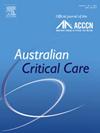Rationalising arterial blood gas sampling analysis in the intensive care unit: A before-and-after study
IF 2.7
3区 医学
Q2 CRITICAL CARE MEDICINE
引用次数: 0
Abstract
Background
Arterial blood gas (ABG) sampling is a frequent intensive care unit investigation with associated costs and labour burden. However, frequency of ABG sampling is not evidence based, and its use could be rationalised. Education strategies and other quality improvement methods can likely reduce ABG sampling, reducing cost, saving clinical time, and limiting the volume of blood drawn.
Aim/objective
The aim of this study was to determine whether a multimodal intervention would reduce unnecessary ABG sampling.
Methods
A single-centre before-and-after study was conducted from August 2021 to July 2022 in a 48-bed quaternary Australian intensive care unit. A multimodal intervention, including a visual cue, education sessions, and a clinical decision support tool, was introduced over 6 months. Data were compared between a 3-month preintervention and a 3-month postintervention period. Data were collected on baseline patient demographics, illness severity, admission diagnosis, length of stay, mortality, and the number of ABG samples collected. Analysis of changes in the blood volume drawn, clinical time required, and total cost were derived from simple calculations using the numbers of ABG samples analysed.
Results
The study included 1130 patients. Baseline variables in the preintervention and postintervention cohorts were comparable. The intervention was associated with nearly a 40% reduction in the rate of sampling (incident rate reduction: 0.61, 95% confidence interval: 0.54–0.70). This would yield an aggregate saving approximating 86 L of blood, 2400 h of clinical workload, and an estimated cost of $AUD 39 per patient/day.
Conclusions
A multimodal intervention to rationalise investigations reduced ABG sampling rates. The magnitude of this reduction confers notable reductions in the volume of blood drawn, repurposed clinical time, and financial savings.
重症监护病房动脉血气取样分析的合理化:前后对照研究
背景:体外血气(ABG)取样是一项常见的重症监护病房调查,具有相关的成本和劳动力负担。然而,ABG采样的频率不是基于证据的,它的使用可以合理化。教育策略和其他质量改进方法可能会减少ABG采样,降低成本,节省临床时间,并限制采血量。目的/目的本研究的目的是确定多模式干预是否会减少不必要的ABG采样。方法于2021年8月至2022年7月在一家48张床位的澳大利亚第四重症监护病房进行单中心前后研究。多模式干预,包括视觉提示、教育会议和临床决策支持工具,在6个月内引入。比较干预前3个月和干预后3个月的数据。收集基线患者人口统计数据、疾病严重程度、入院诊断、住院时间、死亡率和收集的ABG样本数量。抽取的血容量、所需的临床时间和总费用的变化分析是通过使用分析的ABG样本数量进行简单计算得出的。结果共纳入1130例患者。干预前和干预后队列的基线变量具有可比性。干预与抽样率降低近40%相关(事故率降低:0.61,95%置信区间:0.54-0.70)。这将节省大约86升的血液,2400小时的临床工作量,估计每位患者每天的成本为39澳元。结论采用多模式干预使调查合理化,降低了ABG的采样率。这种减少的幅度带来了采血量的显著减少、临床时间的重新利用和财政上的节省。
本文章由计算机程序翻译,如有差异,请以英文原文为准。
求助全文
约1分钟内获得全文
求助全文
来源期刊

Australian Critical Care
NURSING-NURSING
CiteScore
4.90
自引率
9.10%
发文量
148
审稿时长
>12 weeks
期刊介绍:
Australian Critical Care is the official journal of the Australian College of Critical Care Nurses (ACCCN). It is a bi-monthly peer-reviewed journal, providing clinically relevant research, reviews and articles of interest to the critical care community. Australian Critical Care publishes peer-reviewed scholarly papers that report research findings, research-based reviews, discussion papers and commentaries which are of interest to an international readership of critical care practitioners, educators, administrators and researchers. Interprofessional articles are welcomed.
 求助内容:
求助内容: 应助结果提醒方式:
应助结果提醒方式:


